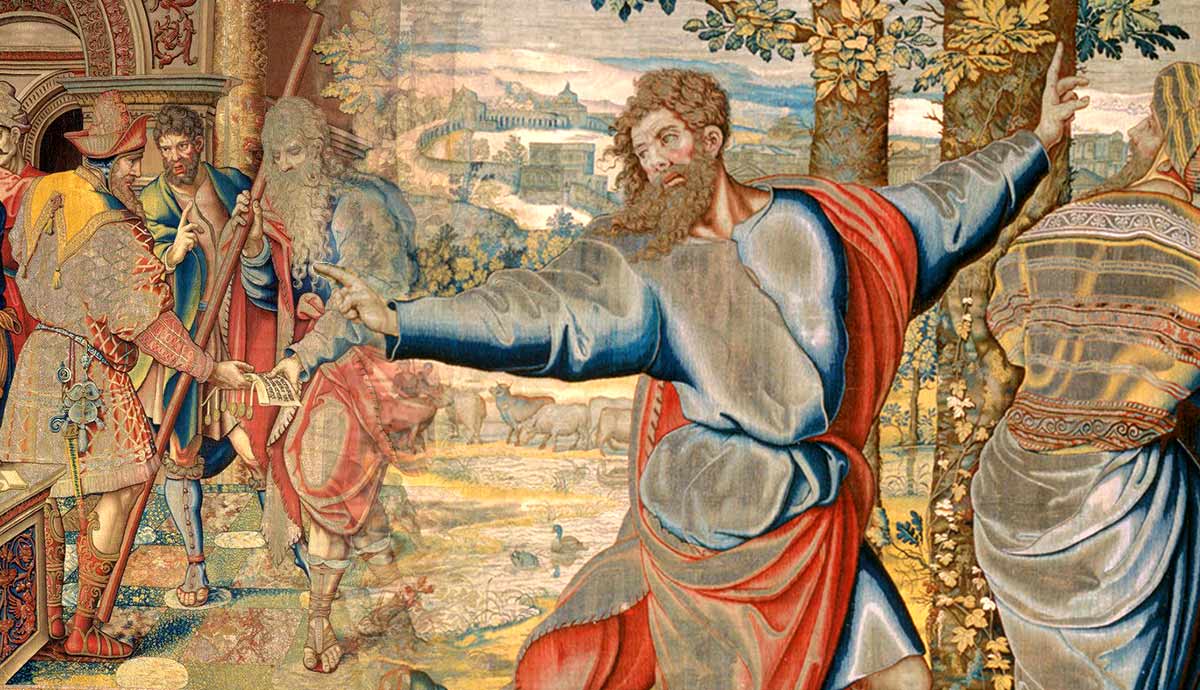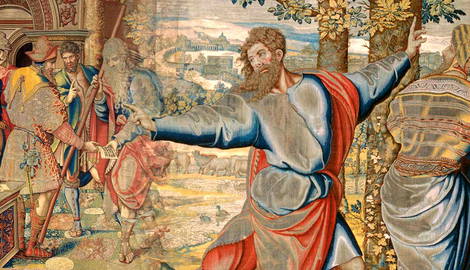
Hampton Court Palace has been a place of decadence and royal pastime since its beginning in the 16th century. Initially built by Cardinal Wolsey, it came into the possession of King Henry VIII, who turned it into a pleasure palace. Some of the most famous tapestries in the world are located here. They were created in Brussels to be sent to England and were commissioned by the King himself. They were made with gold, silver, and silk threads, depicting stories from the book of Genesis. The Abraham Tapestries of Hampton Court Palace continue to symbolize royal splendor.
10 Scenes From The Abraham Tapestries

The Abraham Tapestries are a series created by the Flemish artist Pieter Coeck van Aelst and commissioned by King Henry VIII in the 16th century. Though faded by their 500 years of existence, they still have a glow that captures the hearts of visitors every year. The glow comes from their material, as the tapestries are woven with precious materials such as gold and silver. When Henry VIII commissioned the tapestries, he wanted to make an impression.
The series comprises ten scenes from the life of Abraham, as chronicled in Genesis 12-24. Scenes include the Departure of Abraham, The Separation of Abraham and Lot, the Meeting of Abraham and Melchizedek, God Appears to Abraham, the Circumcision of Isaac and the Expulsion of Hagar, the Return of Sarah, the Sacrifice of Isaac, the Purchase of the Field of Ephron, the Oath and Departure of Eliezer, and Eliezer and Rebecca at the Well.
What Do The Abraham Tapestries Look Like?

The tapestries each show the central scene in the middle of the tapestry, which takes up the majority of the space in the artwork, but around the sides, there is a border that shows various figures that relate to the story presented. In Purchase of the Field of Ephron the Hittite, for example, figures around the border include Lady Justice in the upper right corner (seen holding both scales and a sword to remind viewers that although she may administer justice, she may also take it away), Spes along the bottom of the border (the goddess of hope), or Hera in the upper left corner (the goddess of marriage and childbirth). At the top of each tapestry, a Latin inscription gives viewers a quick description of what is happening in the presented scene.
It is unclear whether or not these figures were chosen by King Henry VIII when he commissioned the artworks or if Pieter Coeck van Aelst chose the figures as the designer of the tapestries. Nevertheless, the figures hold symbolic meaning for the King, centering around his hope for a son and heir to the throne of England, for a continuation of the dynasty his father had created, and for justice against those who oppose his rule. Henry VIII had many reasons to fear people doubting his rule, especially after he broke from the Catholic Church. This was not a popular decision, and he faced rebellion in his kingdom after the dissolution of the monasteries. Asserting his rule and his son’s dynastic inheritance was necessary to remind people of his divine right to rule, given to him by God. Overall, there are over a hundred figures in the borders of the ten tapestries.
Who Designed the Abraham Tapestries?

The Abraham Tapestries were designed by the Flemish artist Pieter Coeck van Aelst and woven in the workshop of Willem Pannemaker (also called Willem de Kempeneer), located in Brussels. The set located at Hampton Court Palace was not the only set created. There is evidence of two more identical sets being created for royal courts in Madrid and Vienna, both of which also survive into the present day. However, the set commissioned by Henry VIII is the only set that used precious materials in its makeup, leading art historians to believe that the English King was the original commissioner and that the other sets were less expensive copies. It was not uncommon for copies of tapestries to be made. An artist would design a cartoon to be made into a tapestry by creating a painting, a print, or some other form of artwork, and then that artwork would be made into a tapestry at a workshop.
Pieter Coeck van Aelst was a fascinating artist from Flanders. Growing up in Aelst, he made his way to Antwerp as an adult to make a living as an artist. Here, he married the daughter of a prominent artist, which brought him connections in the field. His career flourished quickly and he became highly prominent himself. He became well-acquainted with artists like Joos van Cleve and Pieter Bruegel the Elder. It is not surprising that Henry VIII commissioned an artist such as Coeck van Aelst to design his tapestries. The artist was often in Brussels working on cartoons that were meant to be made into tapestries or other forms of art. Unfortunately, in 1550, he and some of his family members would meet their end in Brussels, possibly from one of the epidemics or plagues in the area.
Why Did Henry VIII Commission the Tapestries?

Henry VIII may have commissioned these tapestries to magnify his divine right to rule England. In 1537, he finally received his long-awaited son, the future Edward VI, from his third wife, Jane Seymour. Once he finally had his heir, Henry VIII sought to amplify his claim to the throne through magnificent artwork that would leave any viewer awed by the wealth of the display. The stories, too, would have served as a form of propaganda for the King.
The Departure of Abraham, for example, shows the moment when God appears to tell Abraham that he is to lead the Israelites into Canaan. Similarly, the King was called by God to lead England into the Protestant Reformation. It would have aided in restoring religious legitimacy to his reign amid a time of doubt and turmoil.

Another panel, titled The Circumcision of Isaac and the Expulsion of Hagar, would have enforced his son’s dynastic claims. Abraham’s wife, Sarah, could not conceive a child. In response, she asked Abraham to conceive a child with a woman named Hagar. Abraham and Hagar produced a son named Ishmael, but years later, when Sarah was visited by the Lord and was told she would give birth to a son, she asked God to expel Hagar and Ishmael out of fear for her son’s inheritance. Similarly, Henry VIII had to expel his previous wives to make way for his son and heir, Edward VI.
Henry VIII had a massive collection of tapestries, numbering over three hundred. Only thirty survive to the present day, ten of which are the Abraham tapestries. Their survival is a testament to their inspiring beauty, as tapestries made of precious materials were often broken down so that the gold and silk could be used to pay debts or other expenses as the tapestries became old-fashioned to later generations. The fact that these survived tells us how people appreciated them, even long after their creation.
Where Are the Tapestries Located?

Since arriving at Hampton Court Palace in 1543, the tapestries have rarely been moved from their location. Initially, they would have been hung in the Great Hall, where they are situated today for viewing, but there were a few instances in which the tapestries were moved. For example, they were moved to Westminster Abbey for Queen Elizabeth I’s coronation. The move likely served a similar purpose as Henry VIII’s commission—to send a message about how the ruler was a religious leader. Just like Abraham led the Israelites, the English ruler would lead the English people to Protestant salvation.
The tapestries may also have been moved to Westminster Abbey for Stuart coronations, and there is evidence that they were used for the coronation of James II in 1685. William III also enjoyed the tapestries, having them moved into his private apartments in the late 17th century. The fact that he had 150-year-old tapestries in his private quarters shows their majestic effect on people. Most 150-year-old items would have been seen as incredibly old-fashioned, yet these tapestries remained a favorite.
Despite being in fantastic shape for their age, the Abraham Tapestries are incredibly fragile.
Restorations of the Abraham Tapestries

Queen Victoria and Prince Albert were fond of the tapestries and recognized that they needed restoration if they were to continue to survive. Queen Victoria hired women to restore the tapestries using needle and thread, and they were paid with a grant from Parliament. The women took over forty years to complete their work on all of the tapestries.
In 1912, George V continued his grandparents’ efforts by putting together committees that could be responsible for the restoration of the tapestries. The restoration occurred at Hampton Court Palace after professionals deemed moving them to another location too risky. Each tapestry took five years to complete, with the last one being finished in the 1960s. Despite their restorations, which helped stabilize the tapestries, they are still fragile and, therefore, remain in situ at Hampton Court Palace, behind a separating bar that prevents people from brushing up against them or touching them.
In 2006, one of the tapestries was selected for a PhD student’s dissertation, in which the tapestry had its backing removed to reveal the original colors. The visible sides of the tapestries have faded significantly over their 500 years, and removing the backing of the tapestry allowed those colors to be seen again for the first time in hundreds of years.

The tapestry was photographed thoroughly and recreated digitally. They used this digital version of the tapestry for a show at Hampton Court Palace in 2009, in which the original colors were projected onto the tapestry so that visitors could see what the tapestries would have looked like at the time of their arrival in England. It was a magnificent sight, but the show had to be strict with how often the light shone on the tapestry. The show occurred at a maximum of five times a day and for only six minutes at a time to keep the pigments in the fabric safe from further deterioration. During this exhibition, all ten tapestries could be seen at Hampton Court Palace.
The Abraham Tapestries have captivated viewers’ interest for hundreds of years since their creation. Created by Pieter Coeck van Aelst and commissioned by King Henry VIII of England to ensure his position as a divine ruler and Head of the Church of England, the Abraham Tapestries remain a symbol of the Tudor court. Created from precious materials such as golden thread and silk, they would have glowed with a nearly celestial light to the people who saw them in their glory. It is through careful research and preservation that these tapestries are still available to view today at Hampton Court Palace. Despite their fading, they are a sight to behold.










